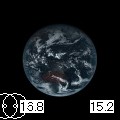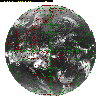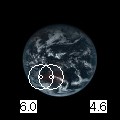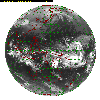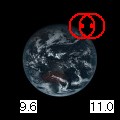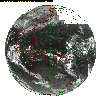Contents
- AHI's automatic sun avoidance function
- Understanding figures on the prediction/results page
- Stray light
AHI's automatic sun avoidance function
Around midnight during the spring and autumn eclipse periods, sunlight can directly enter the AHI sensor when the sun and the earth occasionally lie in an approximate line with the satellite. To avoid this, the AHI has a function by which part of the observation area can be skipped based on prediction of the sun's position and potentially affected areas.
This operation is performed not only in Full Disk observation but also in Japan Area and Target Area observation, resulting in the output image with a partial lack. When the skipped area is expected to cover the whole domain of Target Area observation, the observation will not be performed.
Prediction and results
The pages linked to below provide information on sun avoidance prediction for the forthcoming eclipse period. Actual observation data are also shown for the 2015 spring eclipse period.
Solar interference prediction (click to open/close)
- 2025 spring eclipse periods
- 2024 autumn eclipse periods
- 2024 spring eclipse periods
- 2023 autumn eclipse periods
- 2023 spring eclipse periods
- 2022 autumn eclipse periods
- 2022 spring eclipse periods
- 2021 autumn eclipse periods
- 2021 spring eclipse periods
- 2020 autumn eclipse periods
- 2020 spring eclipse periods
- 2019 autumn eclipse periods
- 2019 spring eclipse periods
- 2018 autumn eclipse periods
- 2018 spring eclipse periods
- 2017 autumn eclipse periods
- 2017 spring eclipse periods
- 2016 autumn eclipse periods
- 2016 spring eclipse periods
- 2015 autumn eclipse periods
- 2015 spring eclipse periods (includs result)
Note: Prediction is based on the assumption of ideal satellite position and attitude. This can cause discrepancies between prediction and actual observation.
Understanding figures on the prediction/results page
Figures with a white background are output from actual observation. Skipped earth areas are shown in white.
Figures with a black background show prediction of the sun's position and potential areas of solar interference. The details are outlined below.
- Small circles represent the predicted position of the sun at the beginning and the end of the timeline.
- Large circles represent 3 degrees of angular distance from the center of small circles at the beginning and end of the timeline. (Angular distance is measured as observed from the satellite.)
- Small/large circles are shown in white when no need for sun avoidance is predicted.
- Small/large circles are shown in red when a need for sun avoidance is predicted. Overlaps with large circles can be considered solar interference areas.
- Angular distances between the center of the sun and the geocenter at the beginning and end of the timeline are shown at the lower left and lower right, respectively.
Stray light
Stray light (a term given to reflected or diffused sunlight entering the sensor) can also be seen in AHI images during eclipse periods. Examples are shown on the Impacts of spacecraft activity and calibration on Himawari-8/9 Images page.
